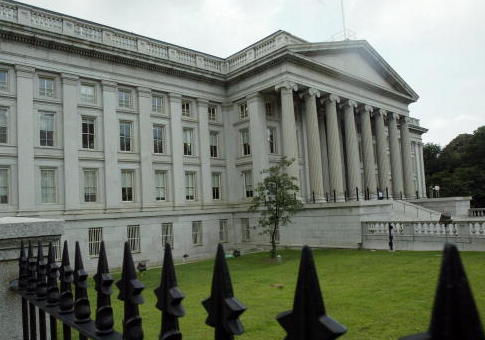Federal debt held by the public is set to hit 77 percent of gross domestic product by the end of this year, the highest level seen since shortly after World War II, according to the Congressional Budget Office's 2017 long-term budget outlook.
Federal debt held by the public, defined as the amount that the federal government borrows from financial markets, has ballooned over the last decade. In 2007, the year the recession began, debt held by the public represented 35 percent of GDP. Just five years later, federal debt held by the public has doubled to 70 percent and is projected to continue rising.
Debt has not seen a surge this large since the increase in federal spending during World War II, when debt exceeded 70 percent of GDP. The budget office projects that growing budget deficits will cause the debt to increase sharply over the next three decades, hitting 150 percent of GDP by 2047.
Deficits are projected to rise over the next few years because government spending is outpacing tax revenue, causing a substantial imbalance in the federal budget. In 2017, the deficit was 2.9 percent of GDP. This is projected to rise to 9.8 percent in 2047.
Spending for all of government programs and activities averaged about 18 percent of GDP over the past 50 years. In 2009, the last year of the recession, that number spiked to 23 percent and is projected to increase to 23.2 percent by 2047.
The majority of the rise in spending is largely the result of programs like Social Security and Medicare in addition to rising interest rates. For example, Social Security and major health care program spending represented 54 percent of all federal noninterest spending, an increase from the average of 37 percent it has been over the past 50 years.
Even though the government is collecting more taxes, it is still not enough revenue to compensate for the increased growth in government spending. Over the next 30 years, individual income tax receipts are projected to increase by 2 percent, increasing from 8.6 percent of GDP to 10.6 percent of GDP. Corporate income taxes are set to decline by only 0.1 percentage point over the next 30 years and payroll taxes are set to decline from 6 to 5.9 percent in 2047.
The budget office says that large and growing debt can pose risks for the United States and challenge policymakers. The increasing debt would constrain budget policy, reduce national saving and increase the likelihood of a financial crisis.
In addition to forecasting estimates about the budget, the CBO calculates projections about economic growth. The budget office projects that the economy will slow down over the next 30 years to 1.9 percent, compared with the 2.9 percent growth seen over the past 50 years. This slowdown, according to the budget office, is due to a slower labor force, a decline in productivity, and increasing interest rates.
"The agency projects that increased borrowing by the federal government under current law generally would crowd out private investment in productive capital in the long term," the report said. "Higher marginal tax rates on labor income also would reduce people's incentive to work, and the increase in the marginal tax rate on capital income would reduce their incentive to save."
